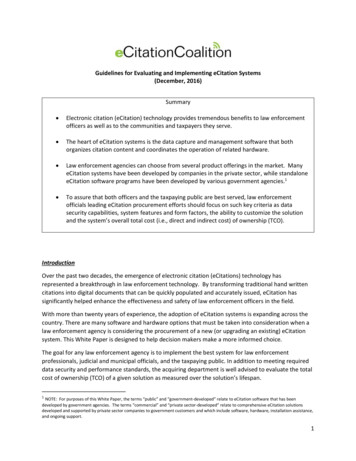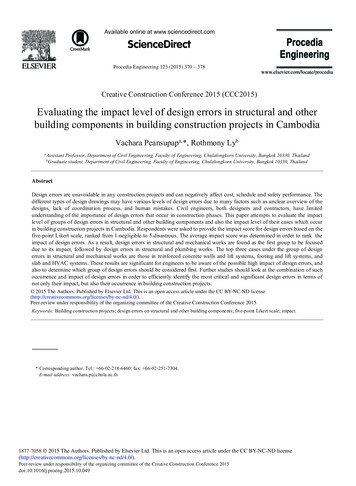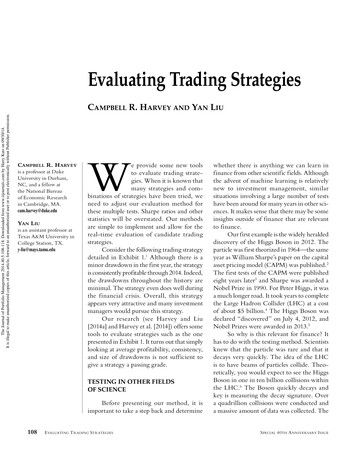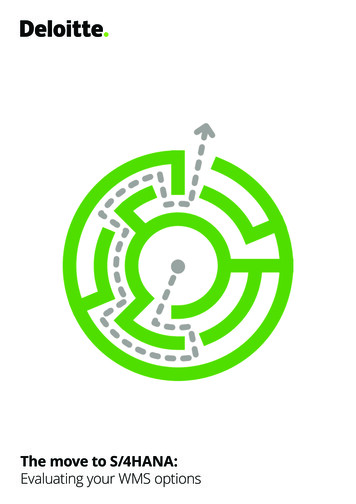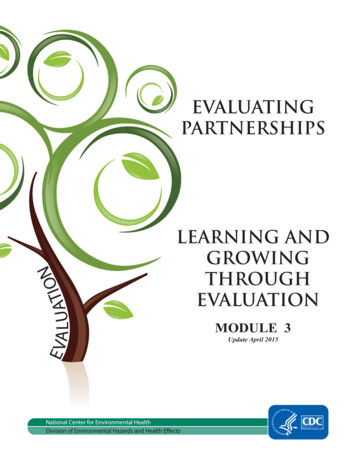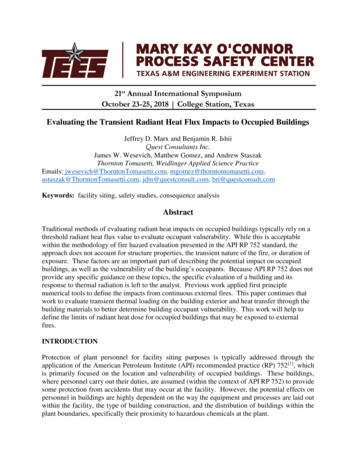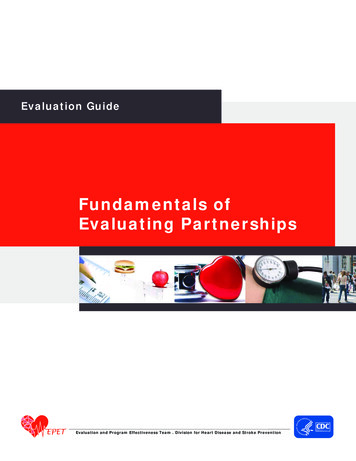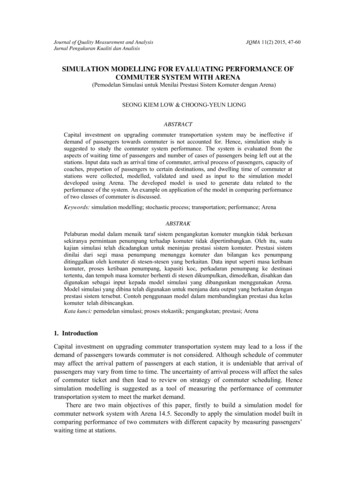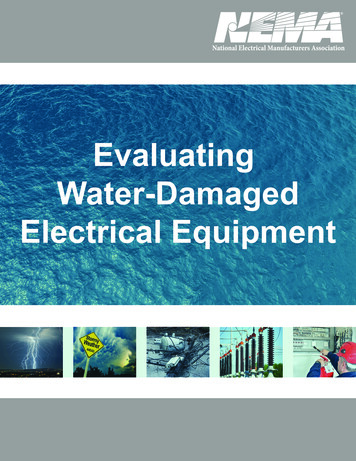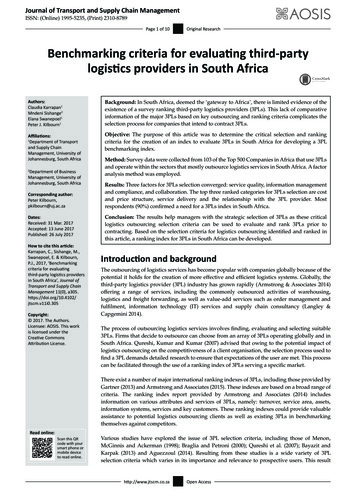
Transcription
Journal of Transport and Supply Chain ManagementISSN: (Online) 1995-5235, (Print) 2310-8789Page 1 of 10Original ResearchBenchmarking criteria for evaluating third-partylogistics providers in South AfricaAuthors:Claudia Karrapan1Mndeni Sishange2Elana Swanepoel1Peter J. Kilbourn1Background: In South Africa, deemed the ‘gateway to Africa’, there is limited evidence of theexistence of a survey ranking third-party logistics providers (3PLs). This lack of comparativeinformation of the major 3PLs based on key outsourcing and ranking criteria complicates theselection process for companies that intend to contract 3PLs.Affiliations:1Department of Transportand Supply ChainManagement, University ofJohannesburg, South AfricaObjective: The purpose of this article was to determine the critical selection and rankingcriteria for the creation of an index to evaluate 3PLs in South Africa for developing a 3PLbenchmarking index.Department of BusinessManagement, University ofJohannesburg, South Africa2Corresponding author:Peter Kilbourn,pkilbourn@uj.ac.zaDates:Received: 31 Mar. 2017Accepted: 13 June 2017Published: 26 July 2017How to cite this article:Karrapan, C., Sishange, M.,Swanepoel, E. & Kilbourn,P.J., 2017, ‘Benchmarkingcriteria for evaluatingthird-party logistics providersin South Africa’, Journal ofTransport and Supply ChainManagement 11(0), ght: 2017. The Authors.Licensee: AOSIS. This workis licensed under theCreative CommonsAttribution License.Method: Survey data were collected from 103 of the Top 500 Companies in Africa that use 3PLsand operate within the sectors that mostly outsource logistics services in South Africa. A factoranalysis method was employed.Results: Three factors for 3PLs selection converged: service quality, information managementand compliance, and collaboration. The top three ranked categories for 3PLs selection are costand price structure, service delivery and the relationship with the 3PL provider. Mostrespondents (90%) confirmed a need for a 3PLs index in South Africa.Conclusion: The results help managers with the strategic selection of 3PLs as these criticallogistics outsourcing selection criteria can be used to evaluate and rank 3PLs prior tocontracting. Based on the selection criteria for logistics outsourcing identified and ranked inthis article, a ranking index for 3PLs in South Africa can be developed.Introduction and backgroundThe outsourcing of logistics services has become popular with companies globally because of thepotential it holds for the creation of more effective and efficient logistics systems. Globally, thethird-party logistics provider (3PL) industry has grown rapidly (Armstrong & Associates 2014)offering a range of services, including the commonly outsourced activities of warehousing,logistics and freight forwarding, as well as value-add services such as order management andfulfilment, information technology (IT) services and supply chain consultancy (Langley &Capgemini 2014).The process of outsourcing logistics services involves finding, evaluating and selecting suitable3PLs. Firms that decide to outsource can choose from an array of 3PLs operating globally and inSouth Africa. Qureshi, Kumar and Kumar (2007) advised that owing to the potential impact oflogistics outsourcing on the competitiveness of a client organisation, the selection process used tofind a 3PL demands detailed research to ensure that expectations of the user are met. This processcan be facilitated through the use of a ranking index of 3PLs serving a specific market.There exist a number of major international ranking indexes of 3PLs, including those provided byGartner (2013) and Armstrong and Associates (2015). These indexes are based on a broad range ofcriteria. The ranking index report provided by Armstrong and Associates (2014) includesinformation on various attributes and services of 3PLs, namely: turnover, service area, assets,information systems, services and key customers. These ranking indexes could provide valuableassistance to potential logistics outsourcing clients as well as existing 3PLs in benchmarkingthemselves against competitors.Read online:Scan this QRcode with yoursmart phone ormobile deviceto read online.Various studies have explored the issue of 3PL selection criteria, including those of Menon,McGinnis and Ackerman (1998); Braglia and Petroni (2000); Qureshi et al. (2007); Bayazit andKarpak (2013) and Aguezzoul (2014). Resulting from these studies is a wide variety of 3PLselection criteria which varies in its importance and relevance to prospective users. This resulthttp://www.jtscm.co.zaOpen Access
Page 2 of 10could be expected based on the view that a wide range oflogistics services are outsourced by firms with differentbusiness strategies and capabilities.Although a broad set of 3PLs selection criteria is availablefrom the literature, it seems that no single criterion issufficient for selection. It is essential for potential users of3PLs to identify and classify key criteria relevant to themin the selection of service provider(s). To establish aranking index for a specific country’s 3PL providers, it istherefore necessary to examine 3PL selection criteria inthe country’s own context and use the theory presentedby the various studies to develop a list of selection criteriathat is relevant and important to the users of 3PLs inthat country.Problem statementSeveral global researchers have published 3PL indexes torank international logistics service providers based on abroad set of criteria. These global reports focus on North andSouth America, Asia and Europe with very little or noinformation on Africa or South Africa, in particular.In South Africa, deemed the ‘gateway to Africa’, there islimited evidence of an index providing a ranking orcomparison of 3PLs available to the local market. Twosupply chain related reports are regularly published butneither of these include a comparison of 3PLs. BarloworldLogistics (2017) annually publishes a report entitled‘Supplychainforesight’, focusing on a variety of relevantsupply chain issues. Since 2016, Stellenbosch Universitypublishes the ‘Logistics Barometer ’ presenting thenational logistics costs in a standardised, internationallybenchmarked format. The latter report replaced the CSIR(2014) ‘Annual State of Logistics Report’, discontinued in2014. However, none of these reports provide a list orranking index of 3PLs available to potential local users ofsuch companies.The research problem therefore is that currently there is alack of comparative information of the major 3PLs in SouthAfrica based on key outsourcing and ranking criteria. Thismakes the selection process difficult for companies thatintend to contract 3PLs. The purpose of this article is toestablish which key outsourcing criteria are important toSouth African users when evaluating 3PLs and to determinehow these users rank the criteria. This information cancontribute to the establishment of a future ranking index for3PLs in South Africa and can be extended to other developingand developed countries.The remainder of this article is organised as follows: Firstly, aliterature review is provided which makes provision for adiscussion of key concepts and the identification of 3PLselection criteria to be evaluated in the context of this study.Then a discussion of the research methodology followed,results obtained, study conclusions and, finally, limitations ofthe study are presented.http://www.jtscm.co.zaOriginal ResearchLiterature reviewThird-party logistics3PLs are ‘those companies that specialise in providingservices such as transportation (inbound and outbound),warehousing, freight forwarding and customs clearance’ (JimWu 2006:505). Wanke (2012:2424) defined a 3PL morecomprehensively as ‘the integrated logistics service providerthat is prepared to satisfy all or most of a client’s logisticsneeds in a customised way’.Logistics outsourcing is defined as ‘a provision of a single ormultiple logistics services by a vendor on a contractual basis’(Mothilal et al. 2012:2409). Soinio, Tanskanen and Finne(2012) suggested that logistics outsourcing is a growingbusiness, and services which are outsourced to 3PLs haveshifted from being a single type of service to a broader rangeof services, including advanced supply chain solutions,resulting in an increase in the trend of logistics outsourcing.Most major sectors, such as information technology,automotive, fast-moving consumer goods (FMCG) andpharmaceutical and retail sectors outsource their logisticsservices to 3PLs (Mothilal et al. 2012). Firms can choose tomanage logistics activities in-house or decide to outsourcespecific activities as a strategic move thereby establishing acompetitive advantage to outmanoeuvre rivals in the marketplace (Brewer, Wallin & Ashenbaum 2014).The reduction of costs is a popular reason for the outsourcingof logistics services (Jacoby 2009; Wanke 2012). However,there are various other potential advantages associated withlogistics outsourcing such as the offloading of capitalintensive logistics assets and access to the best informationsystems and a range of value-added services (Jacoby 2009). Inaddition, through logistics outsourcing a company canimprove customer service levels, increase operationalflexibility and enhance the ability to focus on corecompetencies (Qureshi et al. 2007; Wanke 2012). Furthermore,logistics outsourcing enables a company to convert fixedcosts into variable costs (Bayazit & Karpak 2013) and achievestrategic objectives (Qureshi, Abdelhadi & Shakoor 2014).Outsourcing to 3PLs has the potential for measurable benefitsas found by Langley and Capgemini (2014), who measuredthe tangible benefits to shippers of such outsourcing. Theymeasured reductions in logistics costs, inventory costs andlogistics fixed asset values, while an improvement wasmeasured in order fill rate and order accuracy. Outsourcingtherefore has the potential to make logistics systems moreefficient and effective. High performing logistics systems inturn, enable companies to improve customer service levelsand gain a competitive advantage (Diabat et al. 2013).By means of logistics outsourcing external resources can beleveraged to either manage the entire logistics system or onlyspecific logistics activities. According to Liu et al. (2014),outsourcing activities can be grouped into three areas: basic,customised and advanced, depending on the requirements ofthe company. Logistics outsourcing therefore can include aOpen Access
Page 3 of 10broad range of services including: planning, implementingand controlling of physical flows; storage of raw materials;and management of in-process inventories and finishedgoods (Liu et al. 2014). It can further include directtransportation services, warehouse management, shipmentconsolidation, freight forwarding and payment, orderprocessing and vendor management (Liu et al. 2014).Chen et al. (2010) indicated that organisations mostly outsourcethose logistics activities that are perceived to be non-coreactivities. For the 18th Annual Third-Party Logistics Study(Langley & Capgemini 2014), shippers were surveyed globallyto establish the most commonly outsourced services. Thesurvey showed that the most commonly outsourced servicesare grouped under operational and repetitive activities andinclude: domestic and international transportation (81% and78%, respectively), warehousing (73%), freight forwarding(62%) and customs brokerage (57%). Shippers indicated that afair amount of value-added services (second category) areoutsourced; including cross docking (36%), reverse logistics(36%), freight-bill auditing (33%), product labelling andpackaging (32%), transportation planning and management(28%) and supply chain consultancy services (25%). In thethird category, a moderate outsourcing of strategic and ITintensive services takes place. Examples of these activitiesinclude IT services, order management and fulfilment,inventory management, fleet management, lead logisticsproviders or fourth-party logistics (4PL) services, customerservices, service parts logistics and sustainability or greensupply chain services (Langley & Capgemini 2014). It thereforeappears that the logistics outsourcing industry is a sizeableindustry which is still growing.While different processes can be followed to source 3PLs,they require the identification of potential 3PLs and thecritical evaluation of their services against a set ofpredetermined criteria. Coyle et al. (2009) has developed aseven-step strategic sourcing methodology which requiresthe evaluation of all suppliers, including sourcing of 3PLs.Qureshi et al. (2007) developed a 3PL sourcing process thatwill meet the criteria of the user of such service. In thisprocess the user develops objectives and criteria for therequest for proposals (RFPs) and then evaluates the RFPresponses against an integrated model to identify and classifykey criteria. As approximately 60% of the Fortune 500companies in the United States have a partnership agreementwith a 3PL service provider (Aguezzoul 2014), the need forselection criteria to conduct comparative analysis wouldexist. In South Africa, such information regarding 3PLselection criteria is still lacking.Third-party logistics service provider indexes –comparative analyses3PL surveys which provide a ranking of service providerscan be useful to prospective outsourcing clients. Surveys thatrank 3PLs include those conducted by Gartner (2013) andArmstrong and Associates (2015). Gartner (2013) developedthe ‘Magic quadrant for global 3PL providers’ based on 3PLs’http://www.jtscm.co.zaOriginal Researchcapabilities to provide value-add services in being innovativeand eliminating waste in supply chains, categorising theservice providers into one of four quadrants: challengers,players, niche players and visionaries. The value provided bythe Gardner survey is illustrated by its 2013 report wherefour 3PLs were classified as ‘leaders’, four as ‘challengers’,four as ‘niche players’ and none as ‘visionaries’. The magicquadrant serves as a tool to assist logistics managers tounderstand better the capabilities of 3PLs when selecting aservice provider (Gartner 2013). Gartner’s (2013) report alsoprovides valuable suggestions such as that 3PLs couldprovide more strategic forecasting and direction to shippers.While Gartner (2013) focused more on value-adding services,such as forecasting and innovation, Armstrong and Associates(2015) publish annual 3PL reports, such as the Top 50 global3PLs, Top 20 North American 3PLs and Top 30 United Statesdomestic 3PLs. These reports rank 3PLs according to theirrevenue generation, service area coverage, assets, IT andservices and key customers, but predominantly based onrevenue generation.3PL rankings indexes therefore serve various purposes andare based on different sets of criteria. For the development ofa South African based 3PL index it is a prerequisite to firstexamine logistics service provider selection criteria in theSouth African context by using the theory presented byvarious studies to derive a list of selection criteria that couldbe relevant and important to the users of 3PLs in South Africa.Ranking the third-party logistics service providerselection criteriaAguezzoul (2014) conducted a literature review on criteriaand methods pertaining to the ‘Third-party logistics selectionproblem’. The author’s review of 67 articles publishedbetween 1994 and 2013 reveals that 3PL selection is empiricalin nature and is related to a region or country, industrialsector and the logistics activities outsourced.According to Aguezzoul (2014), some 3PL selection criteriahave common application while others are tailored to specificcustomer requirements. In addition, a firm’s competitivenessstrategy and external environment affect 3PL selection criteria.Nevertheless, Aguezzoul (2014) identified a list of criteriadeemed important when selecting a 3PL and these aresynthesised with those identified by Bayazit and Karpak(2013), Braglia and Petroni (2000), Menon et al. (1998) andQureshi et al. (2007) (refer to Table 1). All these authorsidentified 23 selection criteria of which 15 were identified bymultiple authors: quality of service, information technologycapability, delivery performance, trustworthiness, operationalperformance, compatibility, financial stability, geographicspread and range of services, long-term relationship,reputation, price and optimum cost, surge capacity, flexibilityin operation and delivery, on-time delivery, low error rates andcreative management.Because of the strategic nature of the outsourcing decision, itis logical to assume that prospective outsourcing clientsOpen Access
Page 4 of 10Original ResearchTABLE 1: Third-party logistics service provider selection criteria.TABLE 2: Ranking of third-party logistics service provider selection criteria.3PLs selection criteriaAuthorsRanking Spencer et al. (1994)Moberg and Speh (2004)Quality of serviceBayazit and Karpak (2013); Menon et al. (1998);Qureshi et al. (2007)1.On-time performanceResponsiveness to service requests2.Service qualityQuality of management3.Good communicationTrack record4.ReliabilityAbility to provide value-added services5.SpeedLow costsSize and quality of fixed assetsQureshi et al. (2007)Quality of managementQureshi et al. (2007)Information technology capabilityBayazit and Karpak (2013); Braglia and Petroni(2000); Qureshi et al. (2007)Delivery performanceAguezzoul (2014); Menon et al. (1998); Qureshiet al. (2007)6.FlexibilitySpecific channel expertise7.Customer supportKnowledge of the marketTrustworthinessBayazit and Karpak (2013); Qureshi et al. (2007)8.Easy to work withPersonal relationships with key contactsOperational performanceAguezzoul (2014); Qureshi et al. (2007)9.Management qualityWillingness to assume riskCompatibilityBayazit and Karpak (2013); Qureshi et al. (2007)10.Early notification of disruptionsFinancial stabilityAguezzoul (2014); Bayazit and Karpak (2013);Braglia and Petroni (2000); Menon et al. (1998);Qureshi et al. (2007)Investment in state of the arttechnology11.Order cycle timeSizeGeographical spread and range ofservicesBayazit and Karpak (2013); Braglia and Petroni(2000); Qureshi et al. (2007)12.Willingness to customise service National market coverage13.Reputation-Long-term relationshipBayazit and Karpak (2013); Qureshi et al. (2007)14.Price-ReputationBayazit and Karpak (2013); Braglia and Petroni(2000); Qureshi et al. (2007)15.Location-16.Variety of available services-Price and optimum costAguezzoul (2013); Menon et al. (1998); Qureshiet al. (2007)17.Cost reduction-18.Special expertise-19.Decreased labour problems-20.Technical competence-21.Decreased asset commitment-22.Increased competition-23.Global capabilities-Surge capacityQureshi et al. (2007); Braglia and Petroni (2000)Flexibility in operation and delivery Bayazit and Karpak (2013); Qureshi et al. (2007)On-time deliveryAguezzoul (2014); Bayazit and Karpak (2013);Menon et al. (1998)Responsiveness to unforeseencircumstancesAguezzoul (2014)Low error ratesAguezzoul (2014); Menon et al. (1998)Creative managementAguezzoul (2014); Braglia and Petroni (2000);Menon et al. (1998)Top management commitmentMenon et al. (1998)Availability of top managementAguezzoul (2014)Ability to meet contractualrequirementsMenon et al. (1998)Ability to solve problemsMenon et al. (1998)Source: Aguezzoul (2014:70–77), Bayazit and Karpak (2013:20–13), Qureshi et al.(2007:227–245), Braglia and Petroni (2000:96–111) and Menon et al. (1998:121–137)Note: Please see the full reference list of the article, Karrapan, C., Sishange, M., Swanepoel,E. & Kilbourn, P.J., 2017, ‘Benchmarking criteria for evaluating third-party logistics providersin South Africa’, Journal of Transport and Supply Chain Management 11(0), a305. https://doi.org/10.4102/jtscm.v11i0.305, for more information.3PL, third-party logistics providers.should not only identify appropriate criteria for s
Qureshi et al. (2007) developed a 3PL sourcing process that will meet the criteria of the user of such service. In this process the user develops objectives and criteria for the request for proposals (RFPs) and then evaluates the RFP respo

